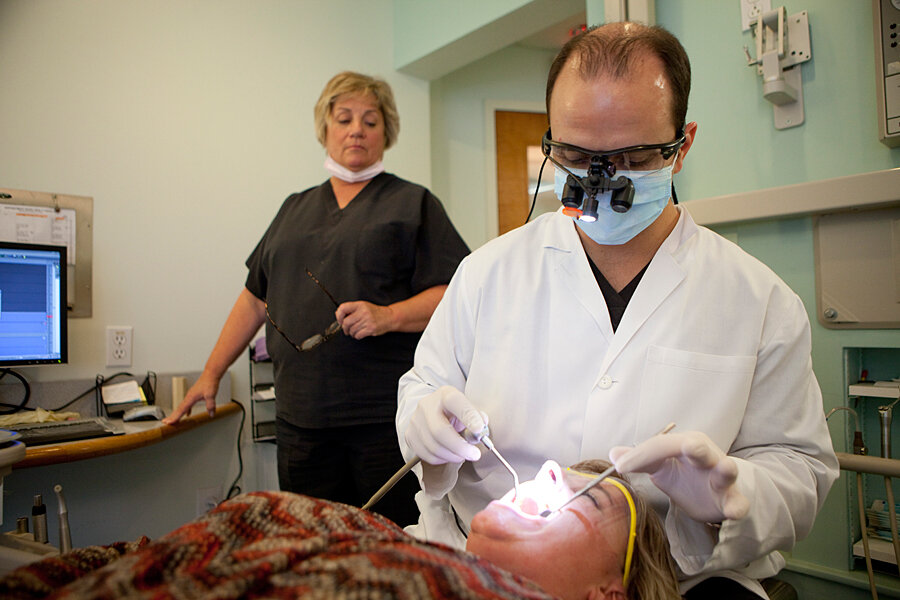Did White House pad Obamacare enrollment numbers?
Loading...
| Washington
Here’s the latest Affordable Care Act surprise: This fall, the Obama administration counted people who’d signed up only for dental plans as full ACA participants, which inflated a key enrollment number.
Cue Democratic face palms. For defenders of the ACA, aka “Obamacare,” this is a stupid mistake in regard to a purely arbitrary goal that could undermine the health-care program’s credibility with voters.
“This is such a dumb, unforced error by the administration,” tweeted Ezra Klein of Vox on Thursday.
Obamacare critics see it as something worse. They call this slip-up a “mistake,” using finger quotes, as opposed to an honest inaccuracy.
“Gosh, that really was an astonishingly lucky mistake, wasn’t it?” writes Charles C.W. Cooke at the conservative National Review Online. “The administration made an error that just happened to push their enrollment numbers above their predicted number. What are the chances!”
Let’s start at the beginning. This past September, the White House released updated figures that claimed the ACA had 7.3 million enrollees. This was good news, according to administration officials, because it meant the program had beaten Congressional Budget Office (CBO) projections that it would serve 7 million people in its first year.
Then the GOP-led House Oversight and Government Reform Committee began picking over raw enrollment data on spreadsheets provided by the Department of Health and Human Services. They discovered that the 7.3 million included 400,000 enrollees whose entries were coded as dental-plan only. So the actual health-care enrollment figure was about 6.97 million.
“Blending dental and medical plans let the administration assert that enrollment remained greater than 7 million, the original CBO projection. The move also partly obscured the attrition of more than 1 million in the number of people enrolled in medical insurance,” writes Alex Wayne of Bloomberg News, who broke the story.
Secretary of Health and Human Services Sylvia Burwell has admitted the mistake in a tweet and said it was “unacceptable.”
To that, Obamacare’s defenders might also add “unnecessary.” Why would the administration bother to inflate its numbers?
After all, 6.97 million for first-year enrollment is pretty much 7 million if you round up, as most analysts would have. Also, the CBO had actually lowered its enrollment projection to 6 million because of the problems encountered by HealthCare.gov in its opening weeks, according to Charles Gaba, a writer who closely follows Obamacare enrollment at his ACASignups.net blog.
Furthermore, it would have represented a perfectly reasonable attrition rate, says Mr. Gaba. “On a policy effectiveness level, this means ... not much at all,” he writes.
But from a political vantage point, “this is probably pretty bad,” he adds.
That’s partly because it’s not occurring in a vacuum. Obamacare architect Jonathan Gruber’s comments that the "stupidity of the American voter” and “lack of transparency” helped the ACA pass have been ricocheting around the media for days. Critics are already charging that Obamacare was passed in part due to lies.
Then there’s the GOP Senate takeover. Congressional challenges to the law will only increase after the turn of the year. Meanwhile, the US Supreme Court is taking up the question of whether the ACA limits Obamacare subsidies to those who buy insurance through state-run, as opposed to federal-run, exchanges.
“The Affordable Care Act’s persistent unpopularity is due not to a communications failure on the part of the administration, as the credulous left comforts itself, but due entirely to its real effects on the public and the scaffolding of lies which have up to now kept the law from imploding. Those structures erected to keep this law from collapsing are now starting to fail,” charges Noah Rothman at the right-leaning Hot Air on Thursday.






